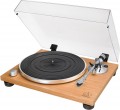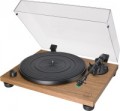Model
Model of the pickup (cartridge) supplied with the player. The pickup is one of the most important parts of any vinyl player, the quality of the received sound largely depends on its quality. Knowing the name of the model, you can find detailed data on it and determine how satisfied you are with this particular cartridge.
Type
The type of pickup (cartridge) supplied with the turntable.
-
MM(with moving magnet). The most common type of cartridges nowadays. The electrical signal in such devices is created by the oscillation of a moving magnet connected to the pickup stylus between special coils. These cartridges give a good output level, making them compatible with the simplest phono stages, they are easy to set up, and the needles in many models can be replaced by the user himself.
-
MC(moving coil). Pickups in which the magnets are made stationary, and the signal is created by a moving coil that vibrates from the vibrations of the needle. This design allows you to reduce the mass of moving parts (compared to MM), which has a positive effect on the accuracy and reliability of sound transmission: MC cartridges are capable of transmitting almost all the nuances of sound. On the other hand, their output signal level is low, which puts forward increased demands on the quality of phono stages and significantly affects the cost. So pickups of this type are typical mainly for high-end equipment.
- MI (with a movable iron element). Quite an exotic type of pickups: the coils and magnets in them are made stationary, and the vibration of the needle sets in motion a miniature piece of magnetic material (for example, iron), which moves between the coils and changes their inductance. Theoretically, such cartrid
...ges can compete with MCs in terms of overall sound quality and detail, while MI technology allows you to achieve a high level of signal output, which does not require expensive phono stages. However, in fact, such pickups are rare for a number of reasons.
Anyway, for the normal operation of the player, a phono stage is required for the corresponding type of pickup; A phono stage may also be built-in (see “Characteristics”), however, if external equipment is used, it is necessary to know the type of pickup to select it.Needle shape
The shape of the needle in the pickup (cartridge) that the player is equipped with.
—
Conical. It may also be called spherical. The simplest type of needles for vinyl players. Such needles are inexpensive, but the sound quality when using them is relatively low — due to the fact that the shape of the needle rather weakly matches the shape of the groove on the record.
—
Elliptical. Elliptical needles have a narrower shape than conical (spherical) needles, which improves contact and allows, in particular, more accurate reproduction of high frequencies, and also reduces record wear. Due to the good value for money, this option is very popular.
—
Linear. The most advanced variety: sharply sharpened needles of complex shape, following the contours of the grooves on the plate as accurately as possible and having the largest contact area among all types. The downside of this is the complexity in production and, accordingly, the high cost.
Pickup weight
The weight of the pickup (cartridge) supplied with the turntable.
The weight of the cartridge determines the characteristics of balancing the tonearm to set the optimal tracking force. However, pickups in set are usually optimally compatible with the corresponding tonearms, so there are no problems with adjusting the turntable. But when buying a replacement cartridge, you should pay attention to this parameter: it is advisable that the new cartridge does not differ too much in weight from the old one, otherwise the tonearm adjustment range may not be enough for the correct balance.
Material
The main material used in the construction of a complete tonearm.
-
Aluminum. This is a fairly lightweight and durable material that has average characteristics in terms of sound quality: it does not dampen extraneous vibrations as well as carbon, but for entry-level and mid-level turntables this is quite enough; in expensive models, you can use other methods of eliminating interference, and aluminum is noticeably cheaper.
—
Carbon. A high-quality material that is lighter in weight and has more advanced anti-resonance properties than the metal described above. The main disadvantage of carbon fiber is its rather high cost.
- Plastic. Plastic is inexpensive, but this is perhaps its only key advantage: the performance characteristics of this material are quite modest. That is why it is used extremely rarely - mainly in retro-style players, where a plastic tonearm is a necessary part from a design point of view.
Speed control
A method for switching the disc rotation speed provided in the player.
—
Manual. This option is only found on belt driven models (see above). It provides the transfer of the belt to another pulley, due to which the gear ratio and, accordingly, the rotation speed change. This method is not as fast and convenient as automatic, however, it allows you to do without unnecessary electronic circuits (many audiophiles appreciate this feature, because additional electronics can interfere and degrade sound quality).
—
Electronic. Speed switching, carried out by changing the parameters of the electric motor — usually, the user just needs to press a button or move the regulator. This method is much faster and more convenient than mechanical, and for direct drive models (see above) is generally the only possible option. However, the electronics responsible for switching the speed affect the cost of the player and can become a source of additional interference; however, the latter can be compensated by installing control circuits in an external power supply (see below).
Connection
—
USB B port. A connector designed to connect the player to a computer as a peripheral device. This connection is mainly used for converting vinyl records to a digital audio format such as MP3. At the same time, computer processing allows you to "clean" the recording from clicks and other extraneous interference; the necessary software for this may even be supplied in the kit.
—
Bluetooth. The presence of a built-in Bluetooth module in the design of the player. This technology is designed for direct wireless communication with other devices at a distance of up to 10 m. The capabilities of such communication may vary, depending on the supported Bluetooth protocols. The most popular use of this feature in players is to broadcast audio to wireless headphones or speakers. Such a connection may be somewhat inferior to a wired one in terms of sound quality, but it does not require fiddling with cables and selecting compatible connectors; and the difference in quality is most often unprincipled, especially considering the characteristics of the sound from vinyl. Other options for using Bluetooth are technically possible — for example, remote control from a smartphone or tablet — but they are extremely rare.
—
Audio input. The presence of an audio input in the design of the player; usually in this case it means a linear analogue audio input. In different model
...s, it can use different types of connectors — for example, 3.5 mm mini-Jack or RCA "tulips". However, regardless of the type of connector, the purpose of such an input is the same everywhere — it is designed to connect an external sound source and process this sound with the player's built-in tools. For example, you can connect a portable player to the audio input and output sound through the built-in turntable amplifier.
— Digital audio output. The presence of a digital audio output in the design of the player. Usually, this output is made in the form of an S / P-DIF connector — optical or electronic; the first option is less susceptible to interference, the second does not require special delicacy when handling the cable. This connector can be useful for connecting external audio devices with digital inputs to the player. In some cases, a digital connection is preferable to an analogue one — for example, if there are no line inputs in an external device or they are all occupied. At the same time, the digital interface requires an analogue-to-digital converter in the "turntable", and these are additional electronic circuits and a potential source of interference. Therefore, such outputs are not used in audiophile-class equipment.
— Headphone output. The presence of a separate headphone output in the design of the player. Typically, this output uses a 3.5 mm mini-Jack or 6.35 mm Jack. The first variety is found in most modern headphones, the second is more reliable and typical for professional models; both interfaces are compatible through a simple adapter. Anyway, connecting headphones can come in handy in two situations: when it is desirable to keep silence and not disturb others with music, or vice versa, when it is noisy around and the sound from the speakers would be hard to hear. Theoretically, the second use case is popular among DJs — in the overall sound, it is important to hear what exactly the turntable is playing at the moment. However, in fact, DJs prefer to connect their "ears" not to the player itself, but to external equipment. Therefore, its own headphone output is typical mainly for consumer-class models.Power consumption
Rated power consumed by the player during normal operation.
Modern turntables are very economical: most models, even those equipped with built-in acoustics (see "Features"), the power consumption does not exceed 15 W, and there is no need to talk about any serious impact on congestion in the electrical networks (as well as electricity bills). The exception is some premium-class devices, in which the weight of the platter (see below) reaches several tens of kilograms, and the corresponding engine power is required to rotate such a mass.

